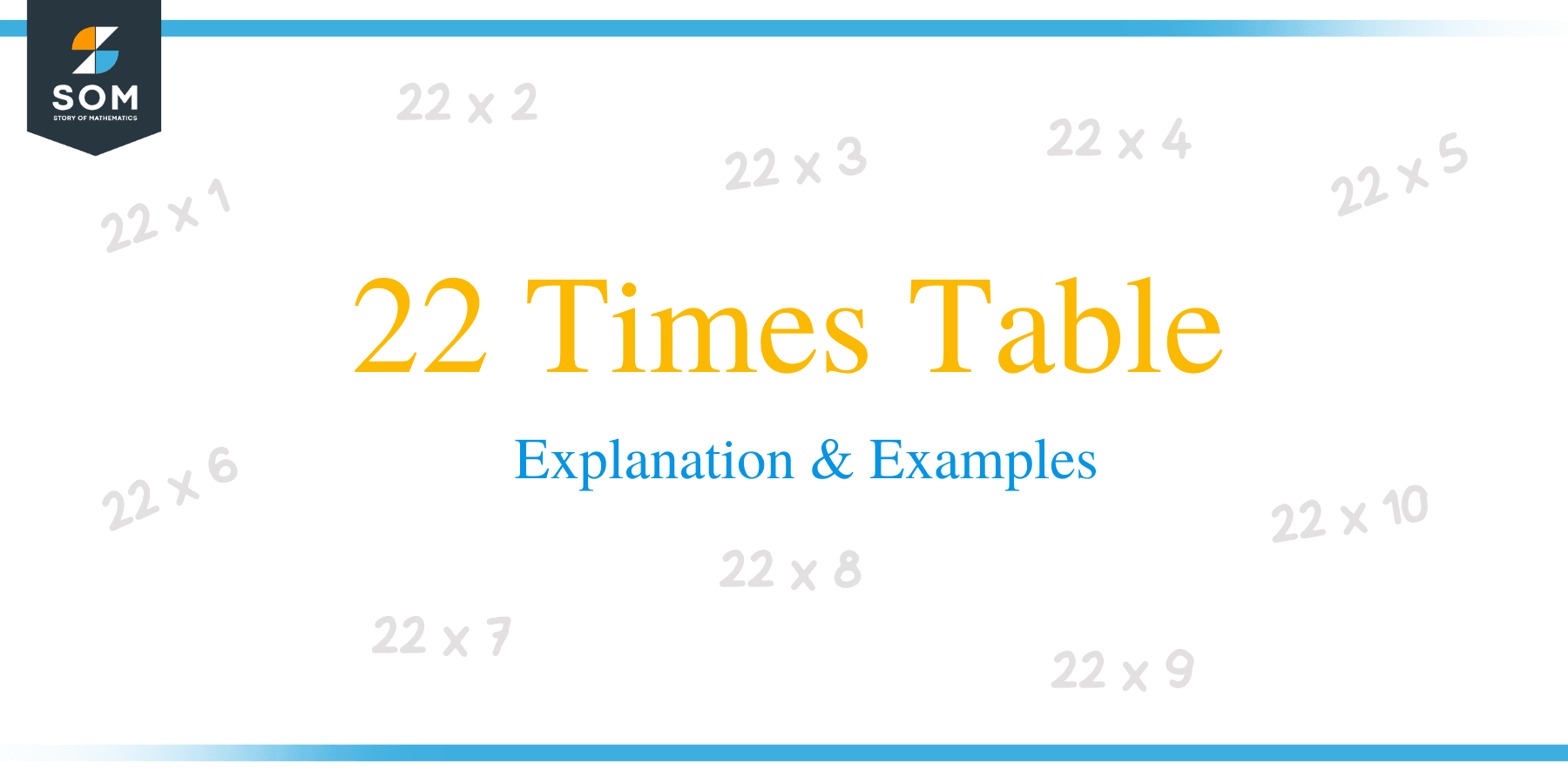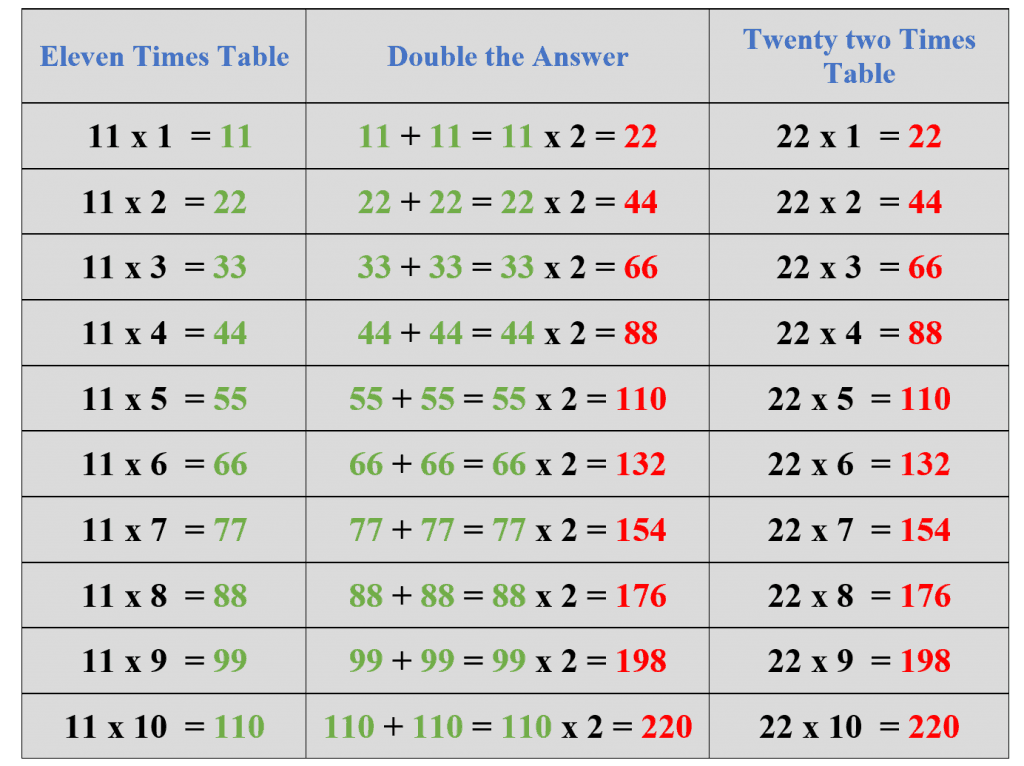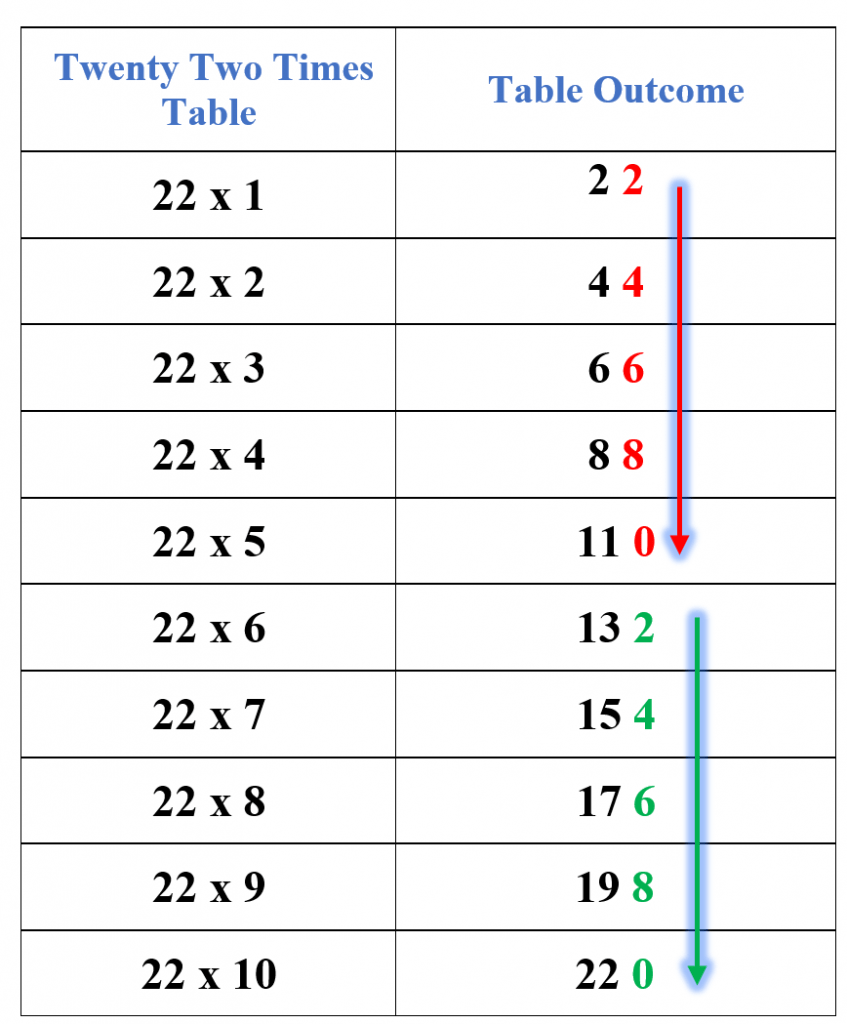- Home
- >
- 22 Times Table – Explanation & Examples
JUMP TO TOPIC
22 Times Table – Explanation & Examples
 The number 22 has some unique characteristics; for example, it is a combination of a repeated prime number, i.e., 2, and divisible by two prime numbers, 2 and 11.
The number 22 has some unique characteristics; for example, it is a combination of a repeated prime number, i.e., 2, and divisible by two prime numbers, 2 and 11.
22 times table is a table that contains the multiples of the number 22.
Learning and understanding the 22 times table is relatively easy. We will provide exciting tips and skills to help you learn and understand the 22 times table on this topic.
You should refresh the following concepts to understand the material discussed on this topic.
- Basics of addition and multiplication
- 2 times table
- 11 times table
- 12 times table
- 20 times table
22 Multiplication Table
The table of 22 can be written as:
- $22 \times1 = 22$
- $22 \times 2 = 44$
- $22 \times 3 = 66$
- $22 \times 4 =88$
- $22 \times 5 =110$
- $22 \times 6 =132$
- $22 \times 7 = 154$
- $22 \times 8 = 176$
- $22 \times 9 = 198$
- $22 \times 10 = 220$
Different Tips for the 22 Times Table:
Let us look at some simple tips which can help you memorize the 22 times table.
Digits Pattern of Odd and Even Numbers: This digit pattern is relatively easy to understand, and you can learn and memorize the 22 times table in a short time once you get the hang of this pattern. First, draw a table having 2 rows and 5 columns, and in both rows, write the digits 2, 4, 6, 8, and 0 as shown in the picture below.

Now write the first four even numbers in the first four cells of the first row and then in the fifth cell, write the odd number which comes after the fourth even number (the fourth even number is 8, and the odd number is 11). Next, in the second row, reverse the process, i.e., write the four odd digits first, and in the last cell, write the even digit that comes after the last odd digit. The resulting table is shown in the picture below and contains the first ten multiples of 22.

Using the 11 Times Table: This method is easy and helps revise the 11 times table, which is pretty easy to remember. In this method, the outcomes of the 11 times table are doubled, i.e., by multiplying by “2” or adding the number to itself. For example, $11\times 5 = 55$, and if we multiply 55 by “2” or add 55 + 55, we get 110, the fifth multiple of 22.

Using the 20 and the 2 Times Table: This method is easy to use if you have memorized the 20 and 2 times tables. It involves adding the multiples of 20 to the same multiples of 2, and the results are the multiples of 22. For example, the fourth multiple of 20 is 80, and the fourth multiple of 2 is 8, and if we add 80 and 8, we get 88 which is the fourth multiple of 22. The detailed method is presented in the table below.
20 Times Table | 2 Times Table | Addition | Outcome |
$20\times 1 = {\color{green}20}$ | $2 \times 1 = {\color{red}2}$ | ${\color{green}20}+ {\color{red}2}$ | $22$ |
$20\times 2 = {\color{green}40}$ | $2 \times 2 = {\color{red}4}$ | ${\color{green}40}+ {\color{red}4}$ | $44$ |
$20\times 3 = {\color{green}60}$ | $2 \times 3 = {\color{red}6}$ | ${\color{green}60} + {\color{red}6}$ | $66$ |
$20\times 4 = {\color{green}80}$ | $2 \times 4 = {\color{red}8}$ | ${\color{green}80}+ {\color{red}8}$ | $88$ |
$20\times 5 = {\color{green}100}$ | $2 \times 5 = {\color{red}10}$ | ${\color{green}100} +{\color{red}10}$ | $110$ |
$20\times 6 = {\color{green}120}$ | $2 \times 6 = {\color{red}12}$ | ${\color{green}120} +{\color{red}12}$ | $132$ |
$20\times 7 = {\color{green}140}$ | $2 \times 7 = {\color{red}14}$ | ${\color{green}140} +{\color{red}14}$ | $154$ |
$20\times 8 = {\color{green}160}$ | $2 \times 8 = {\color{red}16}$ | ${\color{green}160} + {\color{red}16}$ | $176$ |
$20\times 9 = {\color{green}180}$ | $2 \times 9 ={\color{red}18}$ | ${\color{green}180} + {\color{red}18}$ | $198$ |
$20\times 10 = {\color{green}200}$ | $2 \times 10 = {\color{red}20}$ | ${\color{green}200} + {\color{red}20}$ | $220$ |
Unit Digits Pattern: Like the 12 times table, the 22 times table also follows a unit digits pattern of 2, 4, 6, 8, and 0 for 5 multiples of the number 22. If you remember the pattern, it will be easier for you to memorize the 22 times table. The sequence of 2, 4, 6, 8, and 0 repeats itself after every 5 multiples of the number 22. The pattern is shown in the table below.

Table of 22 from 1 to 20:
A complete table of 22 from 1 to 20 can be written as:
Numerical Representation | Descriptive Representation | Product (Answer) |
$22 \times 1$ | Twenty-two times one | $22$ |
| $22 \times 2$ | Twenty-two times two | $44$ |
$22 \times 3$ | Twenty-two times three | $66$ |
$22 \times 4$ | Twenty-two times four | $88$ |
$22 \times 5$ | Twenty-two times five | $110$ |
$22 \times 6$ | Twenty-two times six | $132$ |
| $22 \times 7$ | Twenty-two times seven | $154$ |
$22 \times 8$ | Twenty-two times eight | $176$ |
$22 \times 9$ | Twenty-two times nine | $198$ |
$22 \times 10$ | Twenty-two times ten | $220$ |
$22 \times 11$ | Twenty-two times eleven | $242$ |
$22 \times 12$ | Twenty-two times twelve | $264$ |
$22 \times 13$ | Twenty-two times thirteen | $286$ |
$22 \times 14$ | Twenty-two times fourteen | $308$ |
$22 \times 15$ | Twenty-two times fifteen | $330$ |
$22 \times 16$ | Twenty-two times sixteen | $352$ |
$22 \times 17$ | Twenty-two times seventeen | $374$ |
$22 \times 18$ | Twenty-two times eighteen | $396$ |
$22 \times 19$ | Twenty-two times nineteen | $418$ |
$22 \times 20$ | Twenty-two times twenty | $440$ |
Example 1: Calculate 2 times 9 times 22 minus 270
Solution:
2 times 9 times 22 minus 270 can be written as:
$ = (2\times 9 \times 22) – 270$
$ = 18\times 22 – 270$
$ = 360 – 270 $
$ = 90 $
Example 2: Kevin has a mobile ice cream shop on a truck, and he travels 22 kilometers daily to sell ice cream in the city. Calculate the distance covered by Kevin, if he sells ice cream for
- 10 days
- 13 days
- 15 days
Solution:
Kevin travels 22 kilometers daily on his truck to sell ice cream.
- We can calculate the total distance covered by Kevin in 10 days by using the 22 times table, i.e., $22\times 10 = 220$ kilometers.
- The distance covered in 13 days is $22\times 13 = 286 kilometers$.
- The distance covered in 15 days is $22\times 15 = 330 kilometers$.
Example 3: Calculate 22 times 7 times 2 minus 22 times 10?
Solution:
22 times 7 times 2 minus 22 times 10 can be written as:
$ = (22\times 7 \times 2) – (22\times 10)$
$ = (22\times 14) – (22\times 10)$
$ = 308 – 220$
$ = 88$
Practice Questions:
- Andy saves 22 cents daily. How much money will Andy have at the end of 17 days?
- Subtract the sum of the first 10 even multiples of the number 22 from the first 10 odd multiples of the number 22.
- Calculate 22 times 11 times plus 100 minuses 22 times 7?
- From the given table, select the numbers which are multiples of 22.
| 17 | 18 | 16 | 160 | 150 | 51 | 261 | 280 |
| 221 | 19 | 20 | 18 | 110 | 200 | 267 | 154 |
| 91 | 22 | 13 | 17 | 360 | 103 | 199 | 142 |
| 15 | 230 | 134 | 156 | 330 | 104 | 33 | 138 |
| 226 | 225 | 200 | 25 | 21 | 87 | 141 | 109 |
| 132 | 149 | 55 | 29 | 70 | 88 | 292 | 220 |
| 248 | 132 | 39 | 34 | 154 | 69 | 396 | 229 |
| 310 | 120 | 367 | 39 | 80 | 100 | 352 | 231 |
| 41 | 65 | 45 | 51 | 245 | 122 | 214 | 259 |
| 44 | 43 | 198 | 49 | 80 | 132 | 215 | 119 |
Answer Key:
1) By using 22 times table, we can calculate the total sum saved by Andy, i.e.,
$22\times 17 =374$ cents.
2) We know the first 10 odd multiples of 22 are 22, 66, 110, 154, 198, 242, 286, 330, 374, and 418.
The first 10 even multiples of 22 are 44, 88, 132, 176, 220, 264, 308, 352, 396, and 440.
Sum of the odd multiples is $22+ 66+ 110+ 154+ 198+ 242+ 286+ 330 + 374 + 418 = 2200$.
Sum of the even multiples is $44 + 88 + 132 + 176 + 220 + 264 + 308 + 352 + 396 + 440 = 2420$.
The difference between the sum of even and odd multiples is $= 2420 – 2200 = 220$.
3) 22 times 11 times plus 100 minuses 22 times 7 can be written as:
$ = (22\times 11) + 100 – (22 \times 7) $
$ = 242 + 100 – (22\times 7)$
$ = 242 + 100 – 154$
$ = 342 – 154$
$ = 218 $
4)
| 17 | 18 | 16 | 160 | 150 | 51 | 261 | 280 |
| 221 | 19 | 20 | 18 | 110 | 200 | 267 | 154 |
| 91 | 22 | 13 | 17 | 360 | 103 | 199 | 142 |
| 15 | 230 | 134 | 156 | 330 | 104 | 33 | 138 |
| 226 | 225 | 200 | 25 | 21 | 87 | 141 | 109 |
| 132 | 149 | 55 | 29 | 70 | 88 | 292 | 220 |
| 248 | 132 | 39 | 34 | 154 | 69 | 396 | 229 |
| 310 | 120 | 367 | 39 | 80 | 100 | 352 | 231 |
| 41 | 65 | 45 | 51 | 245 | 122 | 214 | 259 |
| 44 | 43 | 198 | 49 | 80 | 132 | 215 | 119 |
